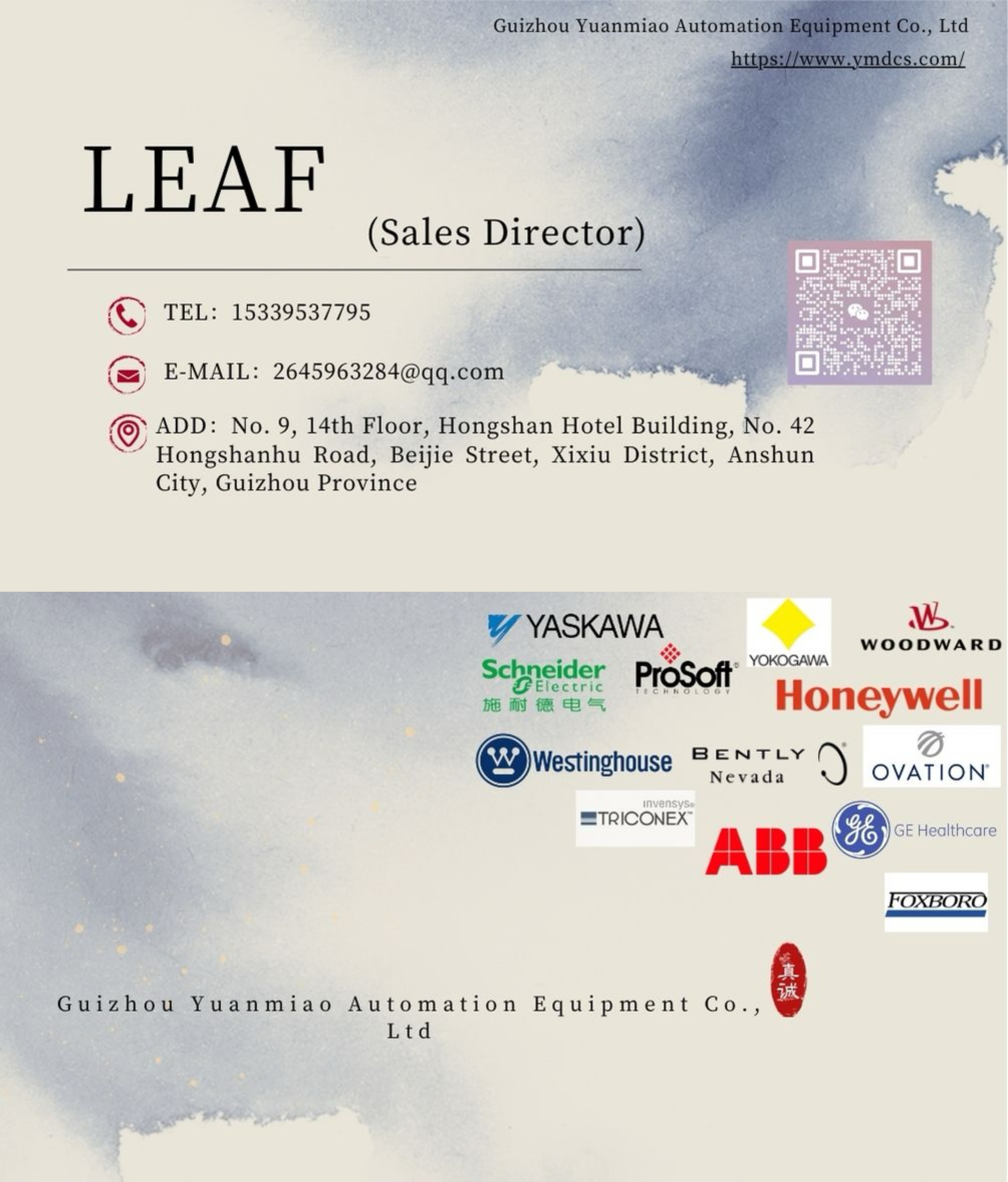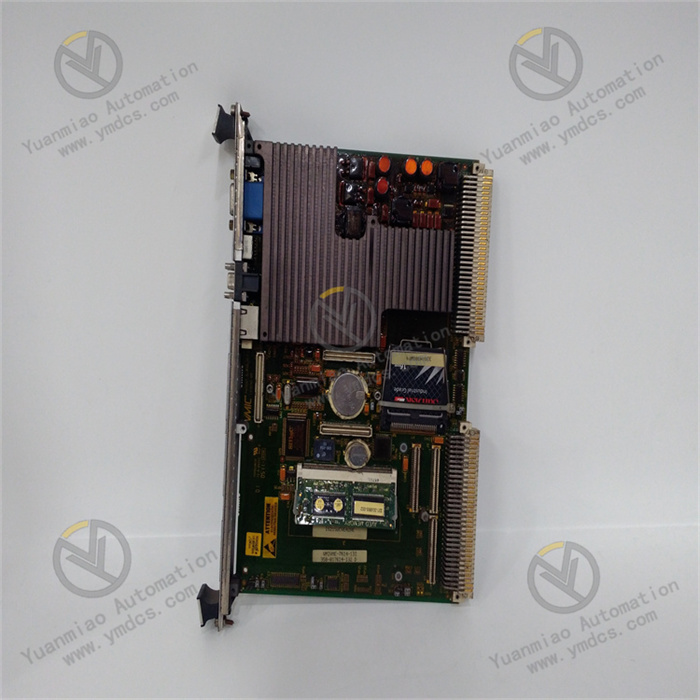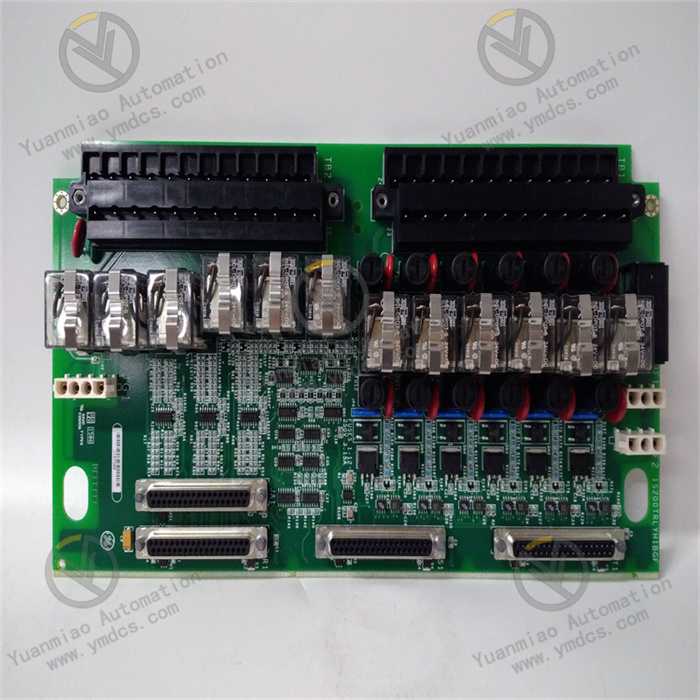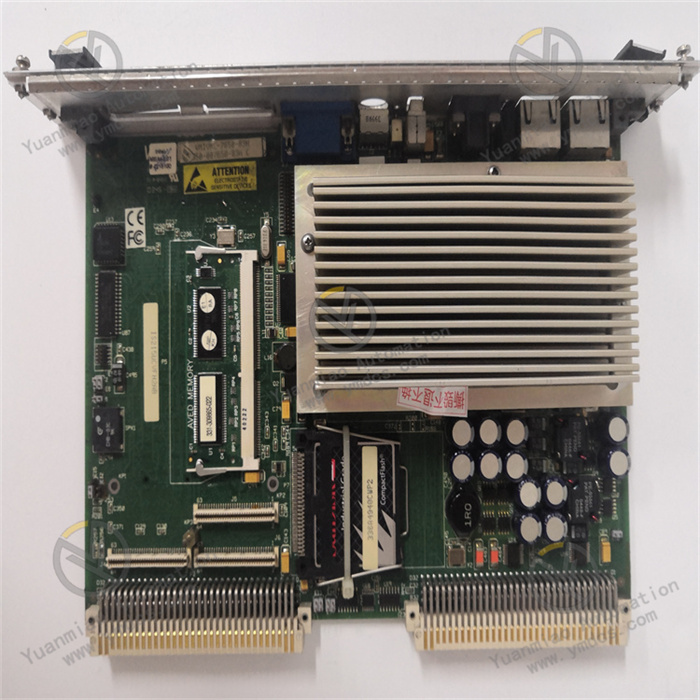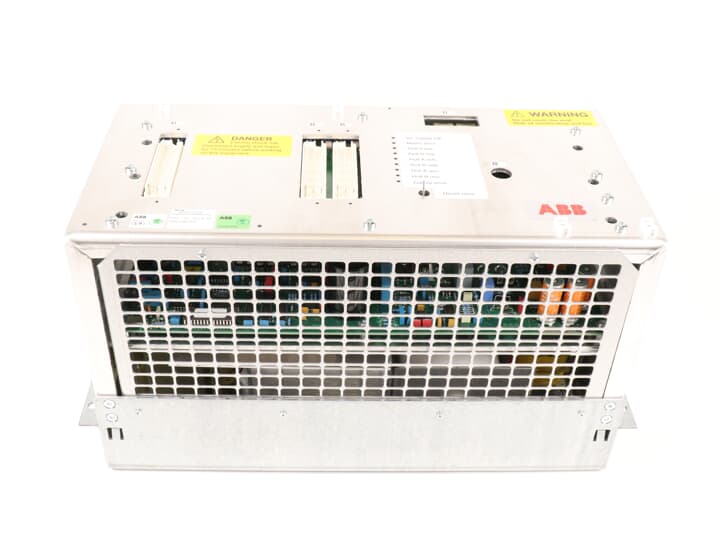Description
GE IS220PPRFH1A
I. Overview
GE IS220PPRFH1A is a process parameter acquisition and regulation module. Its core value lies in providing a process control solution featuring "high-precision acquisition of multi-type process signals, real-time closed-loop regulation, and robust anti-interference processing" for turbine units. Serving as the "data acquisition and execution hub" for turbine process control, it enables the acquisition, filtering, and closed-loop regulation of key process parameters such as main steam pressure, fuel flow rate, and exhaust temperature. It is suitable for process control scenarios of 300MW-1000MW thermal power units and gas turbines in combined cycle power plants, and is a critical component ensuring stable turbine operating parameters and improved unit efficiency.
This module adopts a high-frequency sampling circuit and enhanced closed-loop regulation algorithms, supporting seamless integration with the Mark VIe main control system and turbine actuators (e.g., control valves, frequency converters). It combines acquisition accuracy with regulation response speed, and serves as a core unit in the Mark VIe system for achieving refined control of turbine process parameters.
II. Technical Parameters
(I) Process Parameter Acquisition and Regulation Parameters
1. Signal Input and Output Configuration
- Analog Input (Process Parameter Acquisition): 16 channels of high-precision analog input (16-bit AD, input range of ±10V DC/4-20mA) for collecting key turbine process parameters:
- Pressure Parameters: Main steam pressure (0-30MPa, converted to 4-20mA via pressure transmitter), condenser vacuum (0-100kPa, 4-20mA);
- Flow Parameters: Fuel flow rate (0-100m³/h, 4-20mA), feedwater flow rate (0-500t/h, 4-20mA);
- Temperature Parameters: Exhaust temperature (0-600℃, conditioned to 4-20mA via thermocouple), bearing temperature (0-150℃, RTD signal converted to 4-20mA);Input accuracy is ±0.02% FS, with a sampling rate of 200Hz (high-frequency sampling to capture instantaneous parameter fluctuations), meeting the high-precision monitoring requirements for turbine process parameters.
- Analog Output (Regulation Command Issuance): 8 channels of analog output (16-bit DA, output range of ±10V DC/4-20mA) for sending regulation commands to actuators:
- Valve Regulation: Main steam control valve opening command (4-20mA, corresponding to 0-100% opening), fuel control valve control signal (±10V, compatible with servo valves);
- Pump Set Control: Feedwater pump speed regulation command (4-20mA, controlling frequency converters);Output accuracy is ±0.05% FS, with an output response time of ≤100μs, ensuring rapid execution of regulation commands.
- Digital I/O (Status Monitoring and Interlocking): 16 channels of digital input (24V DC, for collecting actuator status signals and pressure switch signals), 12 channels of digital output (24V DC, for driving interlock relays and alarm lights), with a response time of ≤500μs.
2. Closed-Loop Regulation Performance
- Regulation Algorithms: Built-in library of dedicated closed-loop regulation algorithms for turbines, including:
- PID Regulation: Supports online configuration of proportional band, integral time, and derivative time parameters, suitable for pressure/flow regulation;
- Feedforward-Feedback Composite Regulation: Aims at main steam pressure fluctuations, introduces load feedforward signals in advance, with a regulation overshoot of ≤5%;
- Cascade Regulation: E.g., "main steam pressure - fuel flow rate" cascade regulation (primary regulation for pressure, secondary regulation for flow rate), improving regulation accuracy by 30%.
- Regulation Cycle: Minimum regulation cycle of 1ms (high-frequency regulation, suitable for fast-changing process parameters such as fuel flow rate), with a steady-state error of ≤0.1% FS, meeting the stable control requirements for turbine process parameters.
- Parameter Adaptability: Supports software configuration of input/output signal ranges (e.g., mapping main steam pressure 0-25MPa to 4-20mA) and regulation dead zones (configurable from 0.01% to 1% FS), adapting to turbine units of different capacities.
(II) Communication and Redundancy Parameters
1. Communication Interfaces and Protocols
- Internal Communication (with Mark VIe Main Control): Dual optical fiber interfaces (100Mbps speed, supporting GE SRTP protocol) for redundant communication with Mark VIe controllers (e.g., IS200TBSCH1A), with a data update cycle of ≤1ms, ensuring real-time interaction between process parameters and regulation commands.
- External Communication (with Actuators): 1 EtherNet/IP port (10/100Mbps, compatible with standard actuator protocols), 1 RS-485 port (supporting Modbus RTU protocol for connecting local process instruments such as flowmeters).
- Synchronization Interface: 1 IRIG-B code input interface (time synchronization accuracy of ±1ms), ensuring time consistency between process parameter acquisition and regulation commands, and meeting the timestamp requirements of grid dispatching.
2. Redundancy Configuration
- Communication Redundancy: Dual optical fiber interfaces + EtherNet/IP dual-link redundancy. When the main communication link (e.g., Optical Fiber A) fails, the standby link (Optical Fiber B/EtherNet/IP) switches within ≤100μs without data interruption.
- Power Redundancy: Supports dual-channel 24V DC redundant power supply (input voltage range of 18V-30V DC). The power consumption of a single module is ≤6W (under full-load acquisition and regulation), with automatic switching in case of power failure to avoid power supply interruption.
- Signal Redundancy: Key analog inputs (e.g., main steam pressure) support dual-channel acquisition and comparison. When the deviation between the two channels exceeds 3%, a fault alarm is triggered to prevent regulation failure caused by a single sensor fault.
(III) Electrical and Environmental Parameters (Suitable for Turbine Room Scenarios)
1. Isolation and Anti-Interference
- Isolation Performance:
- Signal Isolation: 2500V AC isolation (1-minute voltage withstand) between analog I/O and communication interfaces; 1500V AC isolation between digital I/O and internal circuits. It resists a common-mode interference voltage of ±300V DC, combating strong electromagnetic interference in turbine rooms (e.g., magnetic fields generated by motors and frequency converters).
- Power Isolation: 2000V AC isolation between input power and internal circuits, with power ripple suppression of ≤50mV (peak-to-peak).
- Electromagnetic Compatibility: Passes IEC 61000-4 series tests, withstanding ±15kV air discharge (ESD), ±4kV electrical fast transients (EFT), and 30V/m radio frequency interference (RFI), far exceeding the anti-interference level of ordinary process control modules.
2. Environmental Adaptability
- Operating Environment: Temperature range of -10℃ to 65℃ (operation without derating, suitable for high-temperature environments in turbine rooms); storage temperature range of -40℃ to 85℃; relative humidity of 5%-95% RH (no condensation, supporting short-term 98% RH humid environments).
- Protection Design: The module itself has an IP20 protection rating (to be installed in a Mark VIe standard control cabinet). The PCB board adopts a reinforced conformal coating (oil-proof and dust-proof, adapting to the oily environment of turbine rooms).
- Anti-Vibration Performance: Complies with IEC 60068-2-6 standard, with a vibration frequency of 10Hz-2000Hz and an acceleration of ≤20m/s², adapting to the vibration environment during turbine operation. The Mean Time Between Failures (MTBF) of the module is ≥200,000 hours.
(IV) System Compatibility and Diagnostic Parameters
1. System Adaptability
- Software Support: Compatible with GE Mark VIe ControlST V10.0 and above versions, supporting graphical configuration of sampling rates, regulation algorithm parameters (e.g., PID parameters), and redundancy strategies. It provides dedicated diagnostic function blocks for process control (e.g., parameter over-range alarm, excessive regulation deviation protection).
- Device Compatibility: Directly compatible with GE EX2100 excitation system, ABB UNITROL 6800 excitation system, Siemens S7-400 process control cabinet, and turbine actuators (e.g., Moog servo valves, Fisher control valves), without the need for dedicated drivers.
- Installation Method: Supports installation in Mark VIe standard I/O racks (directly inserted into rack slots), with dimensions consistent with IS200 series I/O modules (120mm×150mm×30mm), requiring no additional space.
2. Diagnosis and Maintenance
- Local Diagnosis: The module panel is equipped with 16 LED indicators (Power, Comm A, Comm B, AI Fault, AO Fault, Regulation Status). For example, "flashing green Regulation Status light" indicates normal regulation, and "steady red AI Fault light" indicates an analog input fault.
- Remote Diagnosis: Supports remote query of module status (sampled values, regulation deviation, communication error rate) via the Mark VIe main control system. The accuracy of analog input/output can be calibrated online through ControlST software without on-site disassembly.
- Fault Protection: Built-in "process parameter over-limit protection" logic. When overpressure of main steam (>30MPa) or excessively low fuel flow rate (<10m³/h) is detected, it outputs an interlock command within 100μs to shut down relevant actuators and protect the turbine unit.
III. Functional Features
(I) High-Precision and High-Frequency Acquisition, Capturing Instantaneous Fluctuations of Process Parameters
With 16 channels of high-precision analog input and 200Hz high-frequency sampling, it can accurately capture instantaneous changes in turbine process parameters, providing a reliable data foundation for closed-loop regulation. In the main steam pressure control of a 300MW thermal power unit:
- The IS220PPRFH1A collects main steam pressure signals (0-25MPa) via 4-20mA input. The 200Hz sampling rate can capture instantaneous pressure fluctuations of ±0.01MPa (unrecognizable by ordinary modules with 50Hz sampling), avoiding regulation delays caused by sampling lag.
- With an input accuracy of ±0.02% FS, the pressure measurement error is ≤±0.005MPa, providing high-precision data support for PID regulation. The main steam pressure control accuracy is improved from ±0.1MPa to ±0.05MPa, reducing steam waste and increasing unit thermal efficiency by 0.5%.
(II) Multi-Algorithm Closed-Loop Regulation, Adapting to Complex Process Control Requirements
Built-in with multiple algorithms such as PID, feedforward-feedback, and cascade regulation, it can handle the regulation characteristics of different turbine process parameters. In the fuel flow rate control of gas turbines in combined cycle power plants:
- The "feedforward-feedback composite regulation" algorithm is adopted, where the feedforward signal is the unit load command (adjusting fuel flow rate in advance) and the feedback signal is the actual fuel flow rate (correcting regulation deviation). When the load increases from 50% to 100%, the fuel flow rate regulation overshoot is reduced from 10% to 3%, and the regulation time is shortened from 2 seconds to 0.8 seconds, preventing unstable combustion of the gas turbine.
- Aiming at the coupling relationship between fuel flow rate and exhaust temperature, "fuel flow rate - exhaust temperature" cascade regulation is adopted (primary regulation for exhaust temperature with a control target of 600℃, secondary regulation for fuel flow rate). The exhaust temperature fluctuation range is reduced from ±20℃ to ±5℃, extending the service life of the gas turbine combustion chamber.
(III) Robust Anti-Interference and Wide-Temperature Design, Adapting to Harsh Operating Environments
Reinforced electromagnetic isolation and wide-temperature design (-10℃ to 65℃) enable stable operation in strong electromagnetic and high-temperature environments of turbine rooms. In the condenser vacuum control of a 500MW thermal power unit:
- The 30V/m radio frequency interference generated by the operation of frequency converters near the condenser does not affect the module's collection of vacuum signals (0-100kPa). The analog input accuracy remains ±0.02% FS, and the vacuum measurement error is ≤±0.02kPa.
- When the temperature of the turbine room reaches 60℃ in summer, the module operates without derating, and the analog output accuracy does not degrade (±0.05% FS). The condenser vacuum regulation accuracy is maintained at ±0.5kPa, avoiding a decrease in steam turbine efficiency caused by vacuum fluctuations.
- The conformal coating resists oil contamination in the room, allowing the module to operate continuously for 5 years without failure, which is much longer than the average service life of 3 years of ordinary process control modules.
(IV) Intelligent Diagnosis and Online Maintenance, Reducing Operation and Maintenance Risks
Built-in with dedicated diagnostic logic for process control and online calibration functions, it significantly improves operation and maintenance efficiency. In the feedwater flow rate control of a 1000MW supercritical thermal power unit:
- The module continuously monitors the deviation between the dual-channel collection values of feedwater flow rate. When the deviation exceeds 3% (e.g., a single transmitter fault), it immediately reports an "abnormal feedwater flow rate acquisition" alarm. Maintenance personnel can replace the transmitter in advance to prevent feedwater regulation failure caused by signal distortion (each failure results in a loss of over 1 million yuan).
- It supports online calibration of analog output channels. Maintenance personnel can remotely calibrate the output accuracy of feedwater flow rate regulation commands through ControlST software, with a calibration error of ≤±0.02% FS, no shutdown required, reducing unplanned unit downtime.
- When the feedwater flow rate regulation deviation persists beyond 1%, the system prompts "possible control valve sticking", guiding maintenance personnel to conduct timely inspections and preventing feedwater interruption caused by control valve faults.
IV. Application Fields
(I) Thermal Power Industry: Process Control of Thermal Power Units
- 300MW-600MW Subcritical Thermal Power Units: The module collects main steam pressure (0-25MPa), feedwater flow rate (0-400t/h), and exhaust temperature (0-550℃) signals. It controls the main steam control valve and feedwater pump frequency converter by outputting commands via PID regulation. The main steam pressure control accuracy is ±0.05MPa, the feedwater flow rate control accuracy is ±1t/h, and the unit thermal efficiency is increased by 0.5%.
- 1000MW Supercritical Thermal Power Units: Equipped with dual-module redundancy (master-standby mode), it collects reheat steam temperature (0-600℃) and high-pressure cylinder exhaust pressure (0-15MPa) signals. It controls the reheat steam desuperheater valve via cascade regulation, with the reheat steam temperature fluctuation range of ±5℃, meeting the high-precision control requirements of supercritical units.
(II) Combined Cycle Power Plants: Process Control of Gas Turbines
- F-Class Gas Turbine Combined Cycle Units: The module collects fuel flow rate (0-50m³/h), compressor discharge pressure (0-2MPa), and exhaust temperature (0-600℃) signals. It controls the fuel control valve and compressor inlet guide vane (IGV) via feedforward-feedback regulation. The fuel flow rate regulation response time is ≤0.8 seconds, the compressor discharge pressure fluctuation is ±0.02MPa, and the gas turbine power generation efficiency is increased by 1%.
- Distributed Combined Cycle Power Plants: The module connects to local process instruments (e.g., fuel flowmeters) via the EtherNet/IP port and to the remote Mark VIe main control via optical fiber (distance ≤10km), realizing "local acquisition + remote regulation" and adapting to the decentralized layout requirements of distributed power plants.
(III) New Energy: Process Control of Biomass/Waste Incineration Power Plants
- Process Control of Steam Turbines in Biomass Power Plants: Aiming at main steam pressure fluctuations caused by unstable combustion of biomass fuel, the module captures pressure fluctuations through 200Hz high-frequency sampling, filters them, and uploads to the main control. The main control adopts variable-parameter PID regulation (dynamically adjusting PID parameters based on fluctuation intensity), reducing the main steam pressure fluctuation range from ±0.5MPa to ±0.1MPa and preventing steam turbine load fluctuations.
- Process Control of Steam Turbines in Waste Incineration Power Plants: The PCB board of the module adopts an anti-corrosion conformal coating to resist corrosive gases generated by waste incineration. It collects steam turbine bearing temperature signals (0-150℃). When the temperature exceeds 120℃, it outputs an alarm command and adjusts the lubricating oil volume to prevent bearing burnout (each burnout failure results in a loss of over 500,000 yuan).
(IV) Grid Peak-Shaving: Process Control of Pumped Storage Power Plants
- Power Generation Mode of Pumped Storage Units: The module collects turbine inlet pressure (0-10MPa) and power generation flow rate (0-1000m³/h) signals. It controls the guide vane opening via PID regulation, with the inlet pressure fluctuation of ±0.1MPa and the power generation flow rate regulation accuracy of ±5m³/h, ensuring stable power generation of the turbine.
- Pumping Mode: It receives the "pumping mode switch" command from the main control, outputs regulation signals to control the inlet valve opening and pump speed. The inlet valve switching time is shortened from 3 seconds to 1.5 seconds, with no pressure impact during switching (pressure fluctuation ≤±0.2MPa), protecting the turbine and pipeline equipment.
